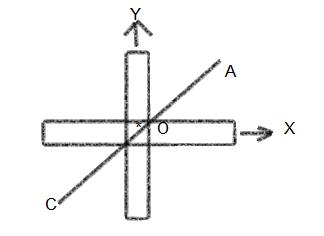can u tell me the answer?
i.e., '0' or 'Ml2/6'
Two uniform, thin identical rods each of mass 'm' and length 'l' are joined to form a cross as shown in the figure. Find the moment of inrtia of the cross about a line AC. (Which is perpendicular to the plane of paper passing through O)
Package says its ML2/6
and if yes... then how does it go fit with perp. axis theorem.
thanks in advance...!!
for additional knowledge, M.I of a thin uniform rod of mass 'm' and length 'l' about an axis passing through its C.M and making an angle 'x' with the rod is
I = MR2/12 sin2x

-
UP 0 DOWN 0 0 5

5 Answers
Note, here the axis is in the plane of the the rods.
Now, take another axis perpendicular to the one given. Obviously, both are same say I. Now by Perpendicular axis theorem, for a perpendicular axis through o, I' = 2I. So You know I' easily, and hence I.
why...??
but we know that moment of inertia about the axis perpendicular to the plane for a thin uniform rod passing through C.M is ML2/12
but in the problem the axis of both the rods make an angle of 0° with the rod so it must be 0
adding them we get 0....!!!!!!!!!
can u explain?
one more problem
2) A bicycle wheel of radius 0.3 m has a rim of mass 1.0 kg and 50 spokes, each of mass 0.01 kg. What is its moment of inertia about its axis of rotation?